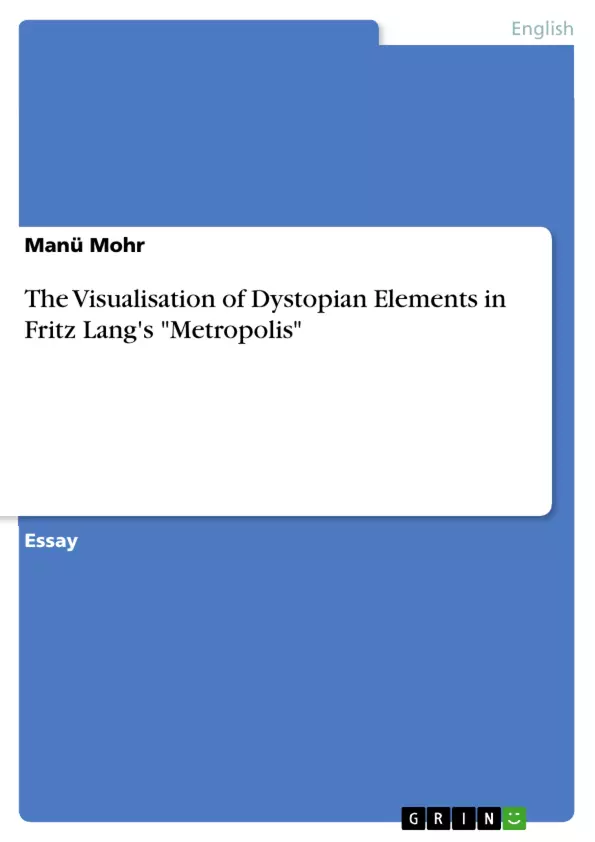The futuristic film “Metropolis” was Fritz Lang's reaction to his trip to New York in 1924. Both being shocked and brimming over with enthusiasm for the city's skyscrapers, cars as well as the rapid development of machines, inventions and thus the whole human life, he was able to realize the dangers that lie therein. It is the aim of this essay to examine how exactly Lang tried to present his fears and speculations to the spectators in order to initiate them in the set of problems depicted in the film. The first thing we see is that in the mega- city Metropolis are living two different classes of society, and the lives of the people could not be more discrete: First of all, the workers in the underground and their depressing living quarters are shown. Everyone is dressed in grey, dark colours prevail and create a melancholy, sad atmosphere. The
uncomfortable environment is dull and suffocating. The men move in a way that resembles a convict's last march to the scaffold, with the music always emphasizing the mood of a scene. They all look to the ground and seem to be tired and hopeless, almost resembling a mass of prisoners. No individuals can be figured out because there is an absolute uniformity and anonymity. Like slaves, they are treated as inferior people having to obey their ruthless masters
who force them to live and work under miserable conditions.
In contrast to this claustrophobic subterranean world, the great city is shown with its numerous skyscrapers and impressive architecture. The carefree ruling class enjoys their live to the full and the sun shines brightly. We see young men doing sports in the open, embodying the direct opposite of the workers previously shown.
Inhaltsverzeichnis (Table of Contents)
- The Visualization of Dystopian Elements in the Prelude
Zielsetzung und Themenschwerpunkte (Objectives and Key Themes)
This essay aims to analyze how Fritz Lang depicted his fears and speculations about societal dangers in his film "Metropolis," specifically focusing on the visualization of dystopian elements in the prelude. The essay examines how Lang presents these concerns to the audience.
- Social Inequality and Class Division
- The Dehumanizing Effects of Industrialization
- The Dangers of Technological Advancement
- Spatial Separation and its Symbolic Meaning
- The Blurring Lines Between Humanity and Machinery
Zusammenfassung der Kapitel (Chapter Summaries)
The Visualization of Dystopian Elements in the Prelude: This chapter analyzes the opening scenes of Fritz Lang's "Metropolis," focusing on how Lang visually establishes the dystopian atmosphere. The stark contrast between the opulent, sun-drenched upper city and the dark, oppressive underworld immediately establishes the film's central theme of social inequality. The chapter details the depiction of the working class as dehumanized, robotic figures, tirelessly toiling in a dangerous environment, while the wealthy elite enjoys leisure and luxury. The introduction of Maria and Freder's subsequent descent into the underworld highlights the spatial and social divide. The chapter also introduces Rotwang, the mad scientist, establishing his role as a harbinger of further technological peril. The juxtaposition of these elements—opulence versus squalor, humanity versus machinery—effectively sets the stage for the unfolding conflict and underscores the film's critique of unchecked industrialization and its impact on society. The chapter also touches upon the symbolic use of clothing, architecture, and even the lighting to amplify the atmosphere of stark contrast and impending conflict.
Schlüsselwörter (Keywords)
Metropolis, Fritz Lang, dystopia, social inequality, industrialization, technology, dehumanization, class division, spatial symbolism, machine man, social commentary.
Frequently Asked Questions: Analysis of Dystopian Elements in Fritz Lang's "Metropolis"
What is the main focus of this analysis?
This analysis focuses on the visualization of dystopian elements in the prelude of Fritz Lang's film "Metropolis," exploring how Fritz Lang visually depicted his anxieties about societal dangers.
What are the key themes explored in the analysis?
The analysis examines several key themes, including social inequality and class division, the dehumanizing effects of industrialization, the dangers of technological advancement, the symbolic meaning of spatial separation, and the blurring lines between humanity and machinery.
What aspects of the film's prelude are analyzed?
The analysis delves into the opening scenes of "Metropolis," specifically examining how Lang visually establishes the dystopian atmosphere through stark contrasts between the upper and lower cities, the depiction of the working class, the introduction of key characters (Maria, Freder, Rotwang), and the symbolic use of visual elements like clothing, architecture, and lighting.
How does the analysis describe the depiction of the working class?
The analysis portrays the working class as dehumanized, robotic figures tirelessly toiling in a dangerous environment, contrasting sharply with the leisure and luxury enjoyed by the wealthy elite. This stark contrast underscores the film's central theme of social inequality.
What role does technology play in the analysis?
The analysis highlights the dangers of unchecked technological advancement and its impact on society. The character of Rotwang, the mad scientist, is presented as a harbinger of further technological peril, emphasizing the film's critique of technology's potential for dehumanization and societal disruption.
What is the significance of spatial symbolism in the analysis?
The analysis emphasizes the symbolic use of space to represent the social and class divide. The stark contrast between the opulent upper city and the dark, oppressive underworld visually reinforces the film's commentary on social inequality. Maria and Freder's descent into the underworld further highlights this spatial and social division.
What are the key takeaways from the chapter summary?
The chapter summary concludes that the juxtaposition of opulence versus squalor and humanity versus machinery effectively sets the stage for the film's unfolding conflict and powerfully underscores Lang's critique of unchecked industrialization and its societal consequences. The skillful use of visual elements amplifies the atmosphere of stark contrast and impending doom.
What keywords are associated with this analysis?
Keywords include: Metropolis, Fritz Lang, dystopia, social inequality, industrialization, technology, dehumanization, class division, spatial symbolism, machine man, and social commentary.
- Quote paper
- Manü Mohr (Author), 2012, The Visualisation of Dystopian Elements in Fritz Lang's "Metropolis", Munich, GRIN Verlag, https://www.grin.com/document/231890



